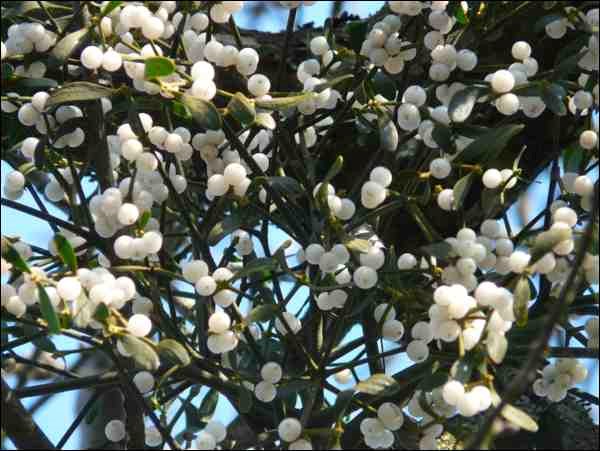Many of our deepest symbolic associations with plants, particularly those centered on holidays such as Christmas, have connections with the past. As our cultural beliefs change slowly over time, so do the meanings of these plants. But, as in the case of mistletoe, their roots run deep.
Most people now associate mistletoe with Christmas and kissing, a tradition dating back to at least 16th century Britain: a young man, upon meeting a girl under the mistletoe hung from the rafters in a farmhouse kitchen, may have the 'privilege' of kissing said girl. The price? Simply picking a berry from the plant. Once all the berries are plucked, no more kisses. This tradition may have derived from early pagan beliefs, where mistletoe represented the male essence, stimulating passion and resulting in increased fertility.
The word is derived from "mistle", an Anglo-Saxon word for dung, and "tan" meaning twig; literally, "dung on a twig." Why this name? Because it would often seemingly appear spontaneously on branches where birds had left their droppings. Because it was thought to arise spontaneously, life-giving powers were attributed to it and often associated with marriage rites, sexuality and fertility.
The Greeks attributed several mystical powers to mistletoe including healing. Pliny the elder reported that the Celts believed it cured barrenness in animals (more fertility beliefs) and was a remedy for poison (life-giving). The ancient Druids of the British Isles especially venerated the mistletoe that grew on oaks, perhaps because it was so rare. During the Middle Ages, mistletoe was hung from ceilings or over doors of homes and stables to ward off evil spirits and prevent witches from entering. It was left up year round and replaced during the winter solstice. It was believed mistletoe growing on an oak could prevent fire.
In Norse mythology, Balder (the god of Peace) was shot and killed with a mistletoe arrow. After he was restored to life (in some versions of the tale), mistletoe was given to the god of love to keep safe, transforming the plant from an emblem of hate to one of love. And perhaps again why mistletoe is associated with kissing, marriage and fertility.
Of the several hundred mistletoe species, only two are used for decorations at Christmas. The original is of European mistletoe (Viscum album) found throughout Great Britain and the continent. The species most commonly used in North America is leafy mistletoe (Phoradendron serotinum), harvested commercially in the south eastern United States. Both have evergreen leaves and clusters of waxy white berries. Although able to photosynthesize, these mistletoe are partially parasitic (hemi-parasite). Their roots grow into tree branches, absorbing water and nutrients from their hosts.
A word of warning: although birds feed on the berries without harm, the leaves, stems and white sticky berries are extremely toxic to humans. Consuming European mistletoe can cause blurred vision, seizures, nausea, low blood pressure, slowed heart rate, confusion, coma and even death. The American mistletoe is thought to be less toxic but can still cause severe gastrointestinal distress (e.g. stomach pain, diarrhea and vomiting). Ancient and/or traditional herbal preparations have been tried for treating cancer, AIDS, high blood pressure, epilepsy, ulcers, infertility, nervousness and other disparate conditions. The druids and ancient Greeks used mistletoe to treat so many ailments that one of its common names translated as 'heal-all." However, none of these uses have been recommended or confirmed by modern medical trials. Pets and children, because of their smaller size, may be more susceptible to the toxic effects of mistletoe. Perhaps there's more than one reason for placing the mistletoe high and out of reach!
- This column is provided by the Saskatchewan Perennial Society




